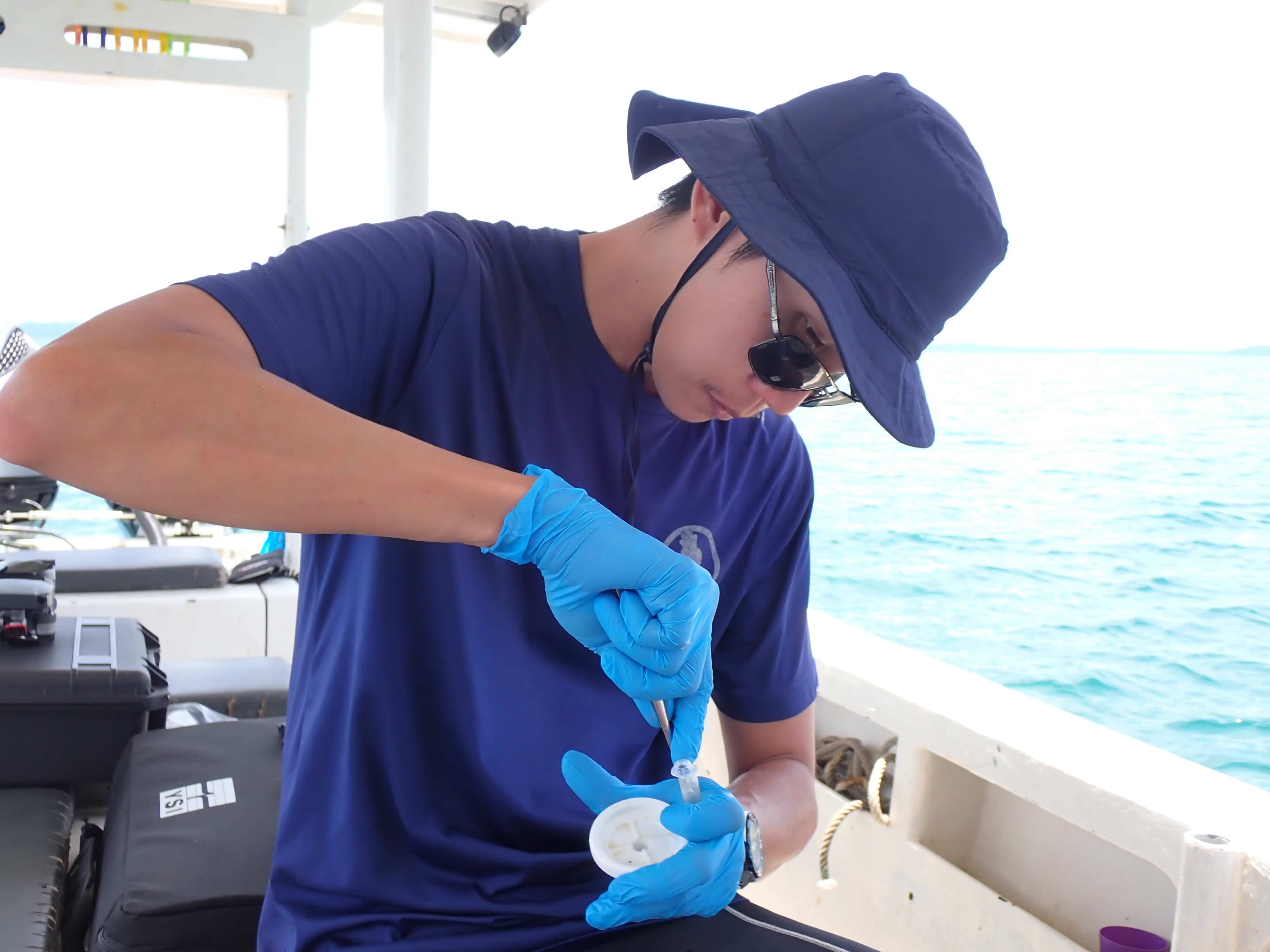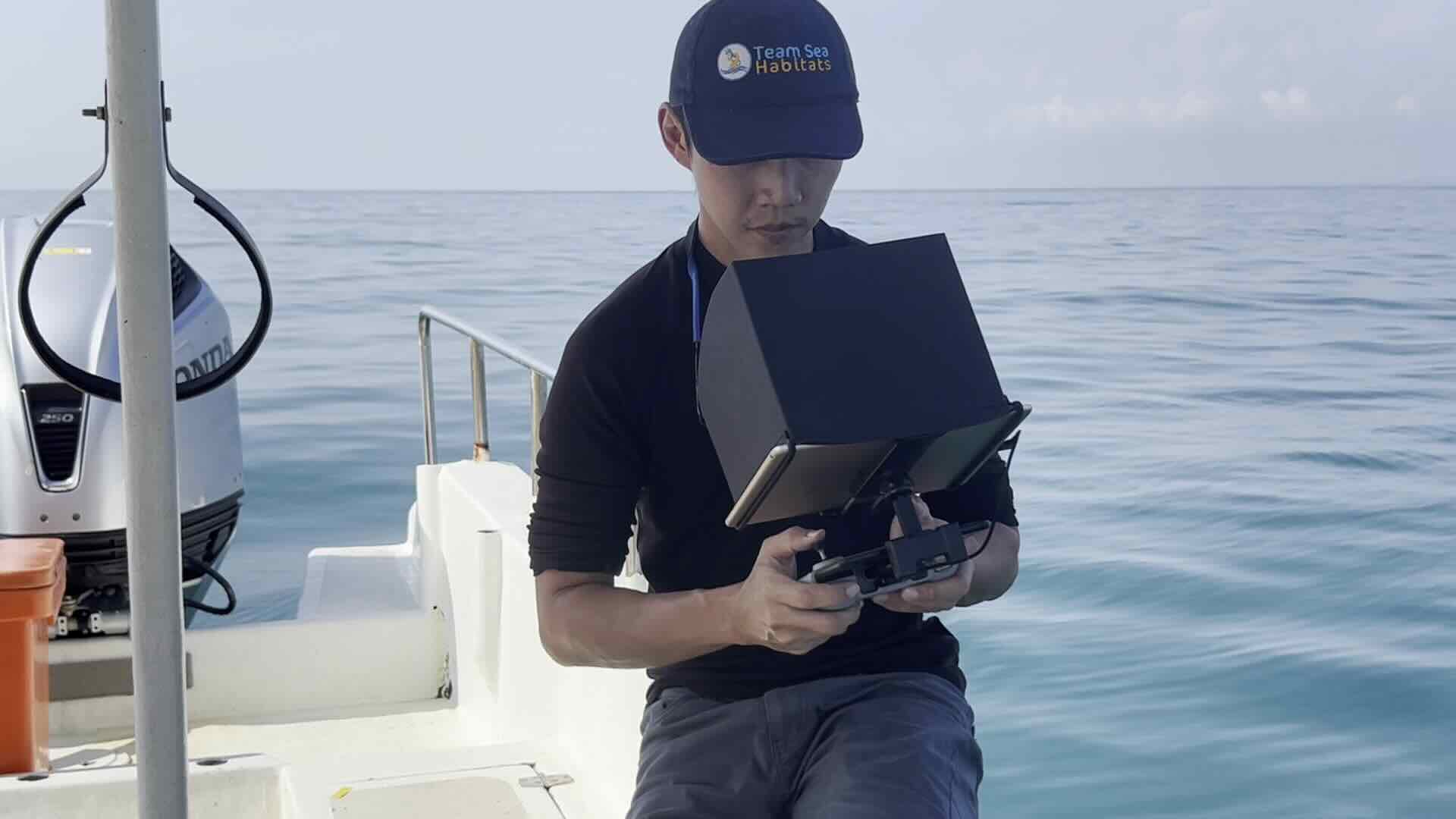Samantha Wong-Topp spoke to Harris Wei-Khang Heng, a PhD student supervised by Associate Professor Daniel Dunn, Professor Peter Mumby and Dr Alison Kim Shan Wee. Harris’s research investigates the influence of seagrass connectivity on the distribution and population structure of megaherbivores at different geographical scales.
He plans to use this knowledge to assess and improve protected area networks with stronger incorporation of connectivity metrics for seagrass and megaherbivores. Here, Sam discusses with Harris everything from his recent National Geographic award to his experience leading a workshop at the International Sea Turtle Symposium.
Congratulations on receiving a National Geographic grant. Can you share more about the project and its objectives?
“Thank you! I’m really excited and honoured to receive this grant from the National Geographic Society for my project, ‘Dugong Connectivity in Southeast Peninsular Malaysia: Innovative Approaches for Challenging Habitats.’ This project collaborates with Universiti Malaya, the University of Nottingham Malaysia and the Kelab Alami (a local community organisation). “Our main objective is to combine two approaches – environmental DNA (eDNA) analysis and unmanned aerial vehicle (UAV) surveys – to improve our understanding of the distribution and population of elusive species like dugongs and green turtles. These species often inhabit seagrass meadows in turbid waters, making it hard to spot them using traditional methods like boat-based visual observation. Manned aerial surveys and satellite tagging, while effective, are cost-prohibitive and require specialised expertise to ensure safety and reliability. That’s where eDNA and UAVs come in. By integrating both methods, we can significantly enhance our ability to monitor these endangered species without relying solely on direct sightings. The two methods complement each other: UAVs provide real-time aerial surveillance, while eDNA allows us to detect the presence of species, even if we don’t physically see the animals. Together, we can gather more detailed information and do it more cost-effectively and less invasively, which is crucial for protecting these endangered species.”

Image credit: Shing Yi Teh
Can you tell me about your recent fieldwork in Malaysia and the key goals you had for the trip?
“My recent fieldwork in the Sibu-Tinggi Archipelago, located in south-eastern Peninsular Malaysia, was really exciting. The seagrass meadows in this region change significantly with the seasons, so our goal is to see if the dugong and green turtle populations follow those patterns. We’re trying to understand how these animals use their habitat over time by combining eDNA sampling with drone surveys. So far, I’ve completed two trips –
one in April (post-monsoon season) and another in July (inter-monsoon season) 2024. I had incredible support from my project assistant, Zarifah, and volunteers, including Jaime Restrepo and Melissa Staines, both CBCS HDR students. Together, we collected eDNA samples from known habitats and spots where dugongs were sighted. Now, you might be wondering – did we actually see any dugongs? Well, the answer is both no and yes. On our first trip, which involved nine days of surveying, we didn’t spot any dugongs, as expected, due to poor seagrass cover. But we did encounter a turtle haven, with sea turtles surrounding our boat as we collected water samples – definitely a highlight of the trip! Then, three months later, during our second trip, we finally spotted them. It was breath-taking! We observed a dugong herd of about 20 animals in loose aggregations. Even more special was witnessing at least four mother– calf pairs, which is a great sign for the population’s health, particularly regarding reproduction. What’s even more fascinating is that they’re still feeding in the same ‘hotspots’ we identified seven years ago based on feeding trails. This shows how indirect evidence, like these trails, can help us uncover patterns for species we don’t often see in the wild.”
You presented at the International Sea Turtle Symposium (ISTS) recently, can you tell me more about that experience?
“It was my first time attending ISTS, and I was amazed by how welcoming the community was. The atmosphere made it easy to feel right at home, which really reflects what the ISTS President said during his opening speech – something along the lines of, ‘When turtle people see each other, they hug, like turtles extending their flippers’. That sense of camaraderie was strong throughout the conference. I presented my first thesis chapter, which is a multilingual systematic review focused on the movement and migratory connectivity of green sea turtles in Southeast Asia. We analysed data from both global and regional literature databases, as well as unpublished sources. Interestingly, we found that nearly two-thirds of the information came from grey literature and unpublished data. What also stood out was how unevenly distributed the evidence is – some countries and certain sampling methods are heavily represented, while others are barely touched. This points to gaps that exist within certain countries, and must be addressed. The main takeaway from my talk was that grey literature holds valuable information that is often ignored, which is a real problem in this region. If we want to protect critical turtle habitats, we need more collaboration at the regional level to fill these knowledge gaps.”

Image credit: Shing Yi Teh
You organised a workshop to address the issue of accessing information and highlighting tools for data- sharing. Can you elaborate on the goals and outcomes of this workshop?
“Before diving into the workshop details, I just want to thank everyone who contributed to its success, which includes Jaime Restrepo, Melissa Staines and Seh Ling Long. It was a team effort, and their support made all the difference. The workshop had two main goals. First, we wanted to bring together researchers, conservationists and government officials to learn about centralised data repositories and innovative tools for long-term monitoring, especially when it comes to sea turtle conservation. Second, we aimed to foster discussions around the data gaps and barriers each country faces in understanding sea turtle movement and habitat connectivity. What really stood out to me was how quickly everyone recognised a common issue – there’s already a wealth of data, but it often just sits unused, and accessing it can feel like an uphill battle. From the start, the participants were eager to collaborate and streamline our data management and sharing strategies, which was great to see. To spotlight practical tools for knowledge transfer, I invited my supervisor, Associate Professor Daniel Dunn, to introduce the Migratory Connectivity in the Ocean (MiCO) system. This platform consolidates data on migratory species like sea turtles and helps generate actionable knowledge for global conservation efforts. We also had a researcher from Universiti Malaysia Terengganu, Dr Mohd Uzair Rusli, present their new Turtle Imprinting Database System (TIDeS), which is designed to make data collaboration much easier for those working in the field. In the long run, I hope this workshop will lay the groundwork for a regional collaborative network, where we can consolidate and deliver usable information to support more effective regional conservation efforts.”
Your workshop brought together 20 to 30 people from all over the world. What was the importance of this global collaboration, and how do you see it impacting future conservation efforts?
“To overcome barriers, we must reshape the systems in place, fostering an environment where communication, collaboration, and reciprocity are the norm—just like in nature, where everything is interconnected and works together. This includes standardising and contributing data to online repositories, reducing barriers to accessing governmental information, and enhancing the capacity of organisations to index and share knowledge effectively. Through this workshop, we opened the door to amplifying the voices of people who are working directly on conservation across different parts of the world. It’s about building bridges that carry different types of knowledge and experience. We need unbiased platforms where everyone can be heard. This kind of collaboration will help us piece together a more comprehensive understanding of what we know, which in turn will guide how we protect and manage sea turtles. At the end of the workshop, I said, ‘Sea turtles in the ocean migrate across borders to progress, and so must we’. That’s what this is all about – working across borders, breaking down silos and moving forward together.”
What’s next for you?
“Having support from organisations like the National Geographic Society, the Rufford Foundation and Auckland Zoo has really pushed me to go beyond what I thought was possible. But even more than that, it’s the people who have been there to guide me, without any conditions, that have made the biggest impact. They’ve helped pave the way, and that’s what’s really gotten me this far in my PhD. Right now, I’ve got a lot going on – balancing research, educational outreach and social engagement, all as part of my conservation efforts. But I think they all fit together really well. They align with the core philosophy of my doctorate, which is constantly asking myself, ‘Why am I here, and what am I doing this for?’ That question keeps me focused on the bigger picture and drives me to keep moving forward.”
To keep up to date on our latest events, check out our Bluesky and LinkedIn.

